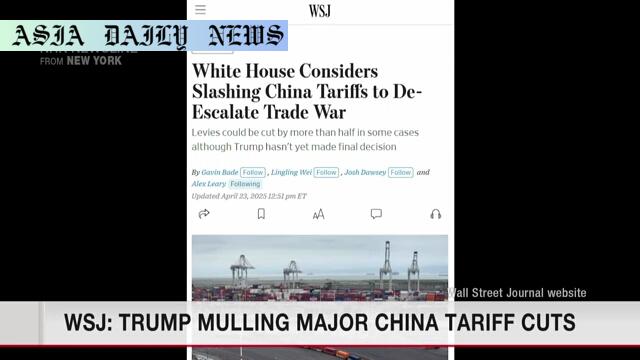Tariffs – Trump’s administration is considering a significant reduction in tariffs on China, potentially cutting them by over half.
Tariffs: US considering cutting tariffs on China over 50%.
Trump aims to ease trade tensions with a ‘fair deal.’
Potential tariff reduction could impact non-security goods.
China urges constructive dialogue over coercive measures.

Background on US-China Tariff Struggles
The relationship between the United States and China over the past few years has been fraught with economic tensions largely stemming from tariffs. Under President Trump’s administration, tariffs were introduced as a tool to address trade imbalances, protect US industries, and counter alleged unfair trade practices by China. Dubbed ‘reciprocal tariffs,’ these measures resulted in significant increases in duties on goods exchanged between the two nations. Presently, US tariffs on Chinese imports stand at an additional 145%, while China has reciprocated with up to 125% increases on American products. These tit-for-tat measures have spurred economic consequences globally.
Considerations for Tariff Reductions
According to The Wall Street Journal, discussions are underway within the Trump administration regarding a substantial reduction of tariffs on Chinese products. Senior officials have reportedly pitched the idea of lowering these rates by as much as 50-65% for products that do not present national security concerns. For many goods classified within lower-risk categories, these tariffs may drop to as low as 35%. The proposed move would signify one of the largest shifts in the ongoing economic exchange between the two superpowers. The ultimate goal is to reduce trade tensions that have challenged industries and disrupted supply chains globally. Sources within the administration insist that no definitive decisions have been made yet, as multiple directions are being considered.
Opinions from Both Sides
President Trump remains consistent in asserting that any policy regarding tariffs must ensure fairness for the United States while rebuilding some semblance of economic equity in dealings with China. “We are going to have a fair deal with China. It’s going to be fair,” President Trump told reporters on Wednesday. On the other hand, China’s Foreign Ministry called for the cessation of coercive order policies and encouraged progress through mutual respect, equality, and benefit-sharing. Chinese spokesperson Guo Jiakun emphasized the importance of de-escalation to pave the way for constructive dialogue.
Global and Domestic Repercussions
Global markets are likely to respond positively to the possibility of lowered US-China tariffs, as they would signify a reduction in trade tensions that have dampened economic growth projections in multiple countries. Domestically in the US, specific industries that rely heavily on Chinese imports—including tech, automotive, and retail sectors—might welcome lower tariffs as a step toward stabilizing supply chains and reducing production costs. Meanwhile, certain policymakers and experts may raise concerns over national security aspects tied to these negotiations, emphasizing a balanced approach that does not compromise critical industries.
The Challenges Ahead
The path to resolving US-China trade conflicts remains complex. While tariff reductions could prove to be an effective strategy in fostering goodwill and cooperation, ensuring these changes reflect the best interests of both nations requires meticulous planning. Domestic stakeholders, including industries that benefited from the protective tariffs, might question whether these reductions undermine the original intent of addressing unfair practices. Amid these discussions, international trade experts also point out the need for structural changes in policies guiding intellectual property rights and technology transfers—areas that have long fueled disputes between the two countries.
Looking Forward
As talks within the Trump administration continue, the direction of US-China trade relations remains uncertain. If tariff reductions move forward as proposed, they could mark a decisive step toward alleviating mounting tensions while promoting global economic stability. However, achieving a truly ‘fair deal’ demands comprehensive engagement from both sides to address deeper issues beyond immediate tariff challenges.



Commentary
The Potential Impact of Tariff Reductions
The news of President Trump’s administration considering major tariff reductions on Chinese goods is a significant development with wide-ranging implications. The trade war between the two largest economies in the world has not only strained bilateral relations but has also had ripple effects on global markets. Any step toward de-escalation could bring much-needed relief to industries burdened by inflated import costs and disrupted supply chains.
A Balancing Act for Policymaking
That said, reducing tariffs is not without its challenges. For one, it represents a shift in strategy for an administration that has long touted tariffs as a means to assert economic strength. While many industries will celebrate lower trade barriers, policymakers must consider whether the reduction undercuts the initial objective of addressing unfair trade practices. Striking this balance will require careful negotiation to ensure that U.S. interests are protected while fostering goodwill with China.
The Larger Economic Picture
In a broader context, tariff reductions could be the first step in addressing deeper structural issues in U.S.-China economic relations. Intellectual property theft, technology transfer practices, and trade imbalances remain unaddressed. If the tariff reductions lead to constructive dialogue on these issues, it could signal a turning point. However, achieving a fair, equitable agreement requires trust and cooperation—qualities that have often been in short supply during this trade war.
Conclusion
Ultimately, the possibility of lower tariffs is a promising sign but not a guarantee of resolution. Both nations stand to gain by working toward a mutually beneficial agreement. It remains to be seen how these discussions will shape the trajectory of one of the most critical trade relationships in the world.